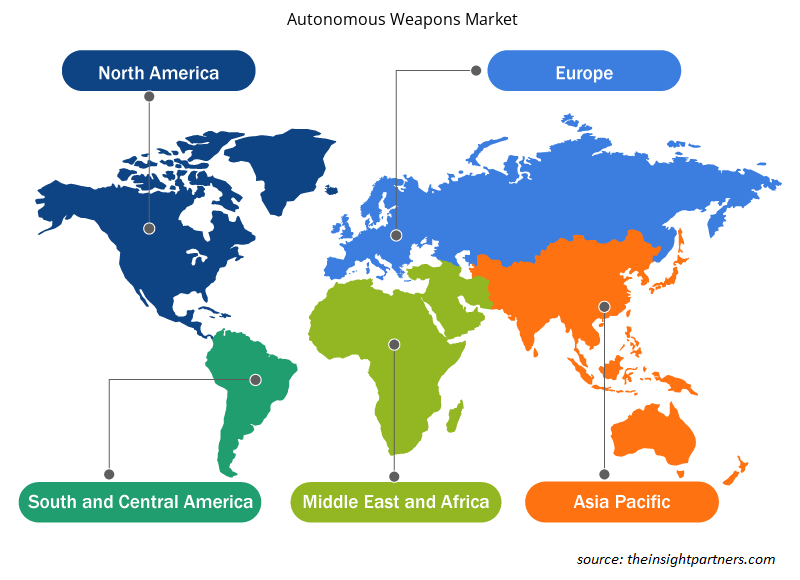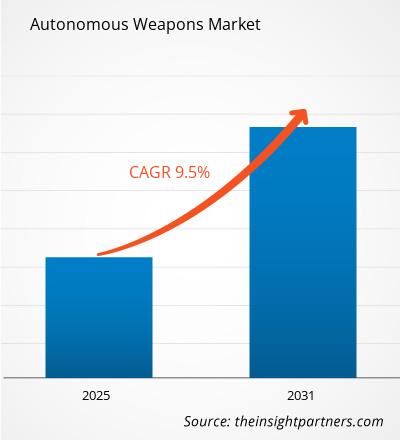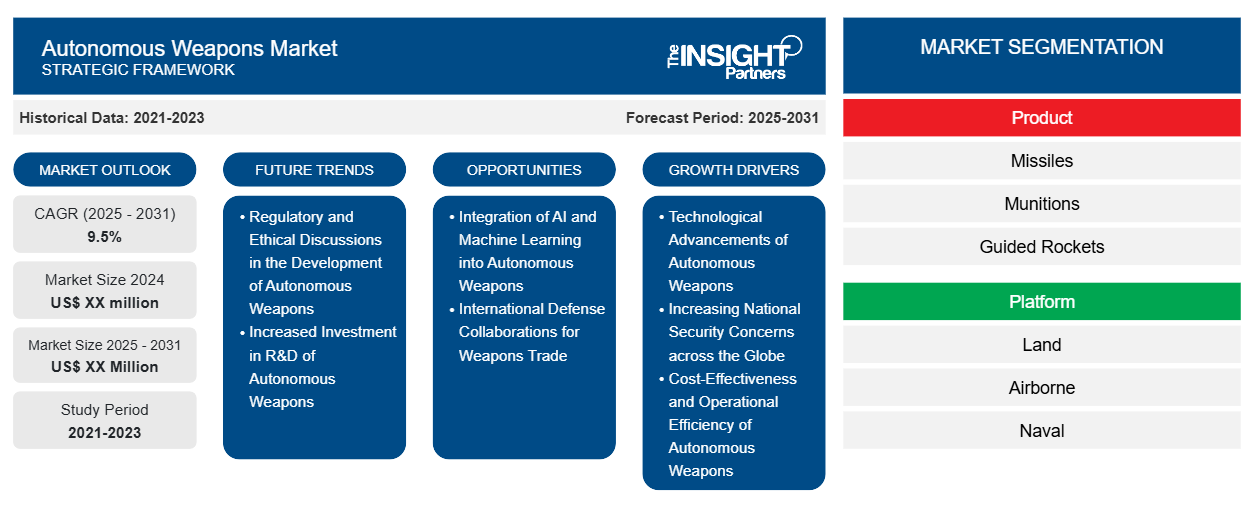Le marché des armes autonomes devrait enregistrer un TCAC de 9,5 % de 2023 à 2031, avec une taille de marché passant de XX millions USD en 2023 à XX millions USD d'ici 2031.
Le rapport est segmenté par produit (missiles, munitions, roquettes guidées, projectiles guidés, arme hypersonique, autres) ; plateforme (terrestre, aéroportée, navale) ; type (semi-autonome, autonome). L'analyse globale est ensuite décomposée au niveau régional et par principaux pays. Le rapport offre la valeur en USD pour l'analyse et les segments ci-dessus.
Objectif du rapport
Le rapport sur le marché des armes autonomes de The Insight Partners vise à décrire le paysage actuel et la croissance future, les principaux facteurs moteurs, les défis et les opportunités. Cela fournira des informations à diverses parties prenantes commerciales, telles que :
- Fournisseurs/fabricants de technologie : pour comprendre l’évolution de la dynamique du marché et connaître les opportunités de croissance potentielles, leur permettant de prendre des décisions stratégiques éclairées.
- Investisseurs : Effectuer une analyse complète des tendances concernant le taux de croissance du marché, les projections financières du marché et les opportunités qui existent tout au long de la chaîne de valeur.
- Organismes de réglementation : Réglementer les politiques et surveiller les activités du marché dans le but de minimiser les abus, de préserver la confiance des investisseurs et de maintenir l’intégrité et la stabilité du marché.
Segmentation du marché des armes autonomes
Produit
- Missiles
- Munitions
- Fusées guidées
- Projectiles guidés
- Arme hypersonique
- Autres
Plate-forme
- Atterrir
- Aéroporté
- Naval
Taper
- Semi-autonome
- Autonome
Géographie
- Amérique du Nord
- Europe
- Asie-Pacifique
- Amérique du Sud et Amérique centrale
- Moyen-Orient et Afrique
Géographie
- Amérique du Nord
- Europe
- Asie-Pacifique
- Amérique du Sud et Amérique centrale
- Moyen-Orient et Afrique
Personnalisez ce rapport en fonction de vos besoins
Vous bénéficierez d'une personnalisation gratuite de n'importe quel rapport, y compris de certaines parties de ce rapport, d'une analyse au niveau des pays, d'un pack de données Excel, ainsi que d'offres et de remises exceptionnelles pour les start-ups et les universités.
- Obtenez les principales tendances clés du marché de ce rapport.Cet échantillon GRATUIT comprendra une analyse de données, allant des tendances du marché aux estimations et prévisions.
Facteurs de croissance du marché des armes autonomes
- Progrès technologiques des armes autonomes : Les progrès rapides de l’intelligence artificielle (IA), de l’apprentissage automatique et de la robotique sont des moteurs importants du marché des armes autonomes. Ces technologies améliorent les capacités des systèmes sans pilote, permettant un ciblage plus précis, une meilleure prise de décision et des temps de réponse réduits. Alors que les forces militaires du monde entier investissent dans le développement de systèmes d’armes avancés, l’intégration de l’IA permet aux armes autonomes de fonctionner avec une efficacité et une efficience accrues dans les scénarios de combat. La recherche et le développement continus dans la technologie des capteurs et l’analyse des données améliorent encore les capacités opérationnelles de ces systèmes, stimulant la demande sur le marché.
- Les préoccupations croissantes en matière de sécurité nationale à travers le monde : les préoccupations accrues en matière de sécurité nationale et les tensions géopolitiques alimentent la demande d’armes autonomes. Les pays se concentrent de plus en plus sur le renforcement de leurs capacités de défense pour dissuader les menaces potentielles et maintenir leur supériorité militaire. Le besoin d’armes avancées qui minimisent les risques humains tout en maximisant l’efficacité opérationnelle stimule les investissements dans les systèmes autonomes. Alors que les nations cherchent à relever les défis de la guerre asymétrique et à améliorer leur positionnement stratégique, l’acquisition d’armes autonomes devient une priorité, propulsant la croissance du marché dans ce secteur.
- Rentabilité et efficacité opérationnelle des armes autonomes : La recherche de solutions militaires rentables est un facteur essentiel sur le marché des armes autonomes. Les systèmes autonomes peuvent réduire les coûts opérationnels en minimisant le besoin de personnel humain dans des environnements à haut risque, diminuant ainsi les dépenses de formation et de logistique. De plus, ces armes peuvent fonctionner dans diverses conditions sans fatigue, ce qui conduit à une efficacité opérationnelle soutenue sur de longues périodes. Alors que les budgets de défense sont de plus en plus limités, les organisations militaires recherchent de plus en plus des technologies qui offrent des avantages tactiques tout en optimisant l'allocation des ressources. Cette tendance à la rentabilité contribue de manière significative à la croissance du marché des armes autonomes.
Tendances futures du marché des armes autonomes
- Discussions réglementaires et éthiques dans le développement des armes autonomes : Une tendance notable sur le marché des armes autonomes est la poursuite des discussions réglementaires et éthiques entourant leur développement et leur utilisation. À mesure que les systèmes autonomes deviennent plus répandus dans les applications militaires, des préoccupations concernant la responsabilité, la prise de décision et le respect du droit humanitaire international sont apparues. Les gouvernements, les ONG et les acteurs de l'industrie débattent activement des implications du déploiement d'armes autonomes. Cette tendance conduit à des appels en faveur de réglementations et de lignes directrices claires pour régir leur utilisation, influençant le paysage du marché à mesure que les entreprises adaptent leurs stratégies pour s'aligner sur l'évolution des considérations éthiques et des cadres réglementaires potentiels.
- Augmentation des investissements dans la recherche et le développement d’armes autonomes : On observe une tendance significative à l’augmentation des investissements dans la recherche et le développement (R&D) sur le marché des armes autonomes. Les pays reconnaissant l’importance stratégique des technologies militaires avancées, les budgets de défense sont de plus en plus alloués à des initiatives de R&D axées sur les systèmes autonomes. Cette tendance est motivée par le désir de maintenir la supériorité technologique dans un paysage de défense en évolution rapide. Les entreprises qui accordent la priorité à la R&D dans les armes autonomes sont susceptibles de dominer le marché en développant des solutions innovantes qui répondent aux exigences de la guerre moderne, se positionnant favorablement pour une croissance future et un avantage concurrentiel.
Opportunités du marché des armes autonomes
- Intégration de l’IA et de l’apprentissage automatique dans les armes autonomes : L’intégration de l’IA et de l’apprentissage automatique dans les systèmes d’armes autonomes présente d’importantes opportunités d’innovation et d’expansion du marché. En exploitant les algorithmes d’IA, ces systèmes peuvent améliorer l’identification des cibles, améliorer la connaissance de la situation et tirer des enseignements des engagements passés pour affiner leurs stratégies opérationnelles. Les entreprises qui se concentrent sur le développement de technologies de pointe basées sur l’IA pour les armes autonomes peuvent conquérir une part considérable du marché. Cette opportunité est particulièrement pertinente pour les sous-traitants de la défense et les entreprises technologiques qui peuvent collaborer pour créer des solutions avancées qui répondent aux besoins évolutifs de la guerre moderne.
- Collaborations internationales en matière de défense pour le commerce des armes : La tendance croissante des collaborations et partenariats internationaux en matière de défense ouvre de nouvelles opportunités sur le marché des armes autonomes. Les pays s’engagent de plus en plus dans des projets de développement conjoint et des accords de partage de technologies pour améliorer leurs capacités de défense. De telles collaborations permettent la mise en commun des ressources, de l’expertise et du financement, ce qui permet un développement et un déploiement plus rapides des systèmes d’armes autonomes. Les entreprises qui parviennent à gérer ces partenariats et à s’établir comme des acteurs fiables dans des coentreprises peuvent bénéficier d’un accès accru aux marchés mondiaux, favorisant ainsi la croissance et l’innovation dans le secteur.
Aperçu régional du marché des armes autonomes
Les tendances régionales et les facteurs influençant le marché des armes autonomes tout au long de la période de prévision ont été expliqués en détail par les analystes d’Insight Partners. Cette section traite également des segments et de la géographie du marché des armes autonomes en Amérique du Nord, en Europe, en Asie-Pacifique, au Moyen-Orient et en Afrique, ainsi qu’en Amérique du Sud et en Amérique centrale.

- Obtenez les données régionales spécifiques au marché des armes autonomes
Portée du rapport sur le marché des armes autonomes
| Attribut de rapport | Détails |
|---|---|
| Taille du marché en 2023 | XX millions de dollars américains |
| Taille du marché d'ici 2031 | XX millions de dollars américains |
| Taux de croissance annuel composé mondial (2023-2031) | 9,5% |
| Données historiques | 2021-2022 |
| Période de prévision | 2024-2031 |
| Segments couverts | Par produit
|
| Régions et pays couverts | Amérique du Nord
|
| Leaders du marché et profils d'entreprises clés |
|
Densité des acteurs du marché des armes autonomes : comprendre son impact sur la dynamique commerciale
Le marché des armes autonomes connaît une croissance rapide, tirée par la demande croissante des utilisateurs finaux en raison de facteurs tels que l'évolution des préférences des consommateurs, les avancées technologiques et une plus grande sensibilisation aux avantages du produit. À mesure que la demande augmente, les entreprises élargissent leurs offres, innovent pour répondre aux besoins des consommateurs et capitalisent sur les tendances émergentes, ce qui alimente davantage la croissance du marché.
La densité des acteurs du marché fait référence à la répartition des entreprises ou des sociétés opérant sur un marché ou un secteur particulier. Elle indique le nombre de concurrents (acteurs du marché) présents sur un marché donné par rapport à sa taille ou à sa valeur marchande totale.
Les principales entreprises opérant sur le marché des armes autonomes sont :
- Systèmes BAE
- Dynamique Denel
- Systèmes de mission de General Dynamics
- Industries aérospatiales israéliennes Ltd.
- Société Lockheed Martin
Avis de non-responsabilité : les sociétés répertoriées ci-dessus ne sont pas classées dans un ordre particulier.

- Obtenez un aperçu des principaux acteurs du marché des armes autonomes
Principaux arguments de vente
- Couverture complète : Le rapport couvre de manière exhaustive l’analyse des produits, des services, des types et des utilisateurs finaux du marché des armes autonomes, offrant un paysage holistique.
- Analyse d’experts : Le rapport est compilé sur la base d’une compréhension approfondie des experts et analystes du secteur.
- Informations à jour : Le rapport garantit la pertinence commerciale en raison de sa couverture des informations récentes et des tendances des données.
- Options de personnalisation : ce rapport peut être personnalisé pour répondre aux exigences spécifiques du client et s'adapter parfaitement aux stratégies commerciales.
Le rapport de recherche sur le marché des armes autonomes peut donc aider à ouvrir la voie au décodage et à la compréhension du scénario de l’industrie et des perspectives de croissance. Bien qu’il puisse y avoir quelques préoccupations valables, les avantages globaux de ce rapport ont tendance à l’emporter sur les inconvénients.
- Analyse historique (2 ans), année de base, prévision (7 ans) avec TCAC
- Analyse PEST et SWOT
- Taille du marché Valeur / Volume - Mondial, Régional, Pays
- Industrie et paysage concurrentiel
- Ensemble de données Excel
Rapports récents
Témoignages
Raison d'acheter
- Prise de décision éclairée
- Compréhension de la dynamique du marché
- Analyse concurrentielle
- Connaissances clients
- Prévisions de marché
- Atténuation des risques
- Planification stratégique
- Justification des investissements
- Identification des marchés émergents
- Amélioration des stratégies marketing
- Amélioration de l'efficacité opérationnelle
- Alignement sur les tendances réglementaires





















 Obtenez un échantillon gratuit pour - Marché des armes autonomes
Obtenez un échantillon gratuit pour - Marché des armes autonomes